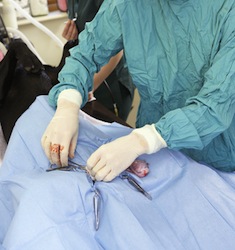The castration of the dog
 The castration of the dog is an intervention of convenience practiced very frequently. This can be decided for various reasons:
The castration of the dog is an intervention of convenience practiced very frequently. This can be decided for various reasons:
– for legal reasons (first category dog),
– to eliminate certain behavioural disorders (Fugue, aggressiveness…),
– to prevent or treat some diseases.
The purpose of this article is to help you know the real benefits of dog castration and understand why this operation is necessary to treat some diseases.
WHY castrated DOG ?
Compliance with the law
A law published in January 1999 concerning dogs "as dangerous", classifies certain types of dogs into categories. Tier Dog owners (including the Pitt bulls) have an obligation to sterilize their dogs at the age of puberty.
Spaying and behavior
Neutering reduces sexual heat of the dog. It decreases So far behaviors Fugue and vagabondage (looking for female dogs in heat) but also the risk of accidents on public roads linked to these fugues.
She presents, Furthermore, the advantage of reducing the fights in families where multiple male dogs. The ideal is even to sterilize these dogs from the age of puberty limiter the risk of developing Conflicts (it is then necessary to sterilize all the dogs of the pack).
Castration in preventing certain diseases
The castration of the dog warns the occurrence of certain higher hormone dependent diseases.
– It allows theavoid the appearance of testicular tumors (relatively common tumors in dogs)
– It limit the risk of occurrence of abscess anal glands,
– It decreases the risk of occurrence of perianal tumors
– It reduces the appearance of a risk perineal hernia,
– 50 to 80% Dogs over 5 years 95% Dogs over 9 years suffer from benign prostatic hyperplasia (increase in prostate size associated with deregulated testosterone secretion). This condition is not always accompanied by clinical signs but can later be complicated by various prostate diseases (abscess, cyst, inflammation…) Neutering prevents the appearance of this phenomenon.
Castration as treatment
Castration is the treatment of choice when:
– torsion testicular
– inflammation testicular
– tumor testicular (after ensuring that no metastasis is present)
– feminization syndrome (phenomenon associated with the development of certain testicular tumors: result of hormonal imbalances, the dog loses its hair symmetrically, especially around the anus and genital area and all over the body, her breasts are growing and reached the male may even begin to secrete milk…)
It is also part of the treatment:
– thebenign prostatic hyperplasia,
– inflammations, abscesses or cysts prostate
Dog Special case cryptorchid
The testicles are not present in scholarships puppy from birth. they "migrate"From the inside of the abdomen to the groin area during gestation and end their journey in the scrotum around age 6 to 8 weeks. In some animals, This "migration" is not performed correctly and testicles or two of rest(nt) intra-abdominal position or stops(nt) in the groin region. The dog carrier of this anomaly is called cryptorchid dog testis and placed in an abnormal position is named ectopic testis.
It is very strongly advised to sterilize these cryptorchid dogs as testicular tumors are much more common on ectopic testes than in normal testicular (risk 14 times).
If castration of the dog has many advantages, it may have some disadvantages that it is good to know to avoid.
finality
The dog's castration is, in the majority of cases, to surgically remove the animal's testicles. It is no longer possible, once animal operated, to obtain offspring. Castration decision must be taken if one does not wish to reproduce his dog.
Weight gain
The declining physical activity and the hormonal changes accompanying castration are often responsible for weight gain in neutered animals.
These factors should be considered when choosing the food distributed after sterilization to limit the risk of developing overweight.
Castration of this dog so few drawbacks. Weight gain can be easily avoided by the establishment of adequate food after sterilization.
She has, on the other hand, undeniable benefits, especially in the treatment of certain diseases.
INTERVENTION IN PRACTICE
The castration of the dog
 The day of surgery, you will be asked to bring your pet fasting for general anesthesia. Neutering the dog is to remove his two testicles. For this, the veterinary practice a single opening, a little behind the penis, by which it successively extracted both testicles. It then closes this opening. The wound healing requires about 10 to 12 days.
The day of surgery, you will be asked to bring your pet fasting for general anesthesia. Neutering the dog is to remove his two testicles. For this, the veterinary practice a single opening, a little behind the penis, by which it successively extracted both testicles. It then closes this opening. The wound healing requires about 10 to 12 days.
Dog Special case cryptorchid
As we mentioned previously, one or both testicles cryptorchid dogs are not located in the usual position.
The surgery is a little different in these animals. If one of the testes is placed in the normal position, it will be extracted as usual. On the other hand, les testicules ectopiques searches doivent être soit dans la région de l'Aine hotels testicules BLOQUES position in groin, either directly into the abdomen of the animal to the testes remained in intra-abdominal position.
These surgeries require the completion of two openings in order to remove both testicles.
§
If the dog sterilization is not as frequent as in the cat or the dog, it is still very useful to solve some problems (disorders cohabitation between male dogs, behavior fugue and vagrancy) but also to treat various diseases (Cryptorchidism, testicular tumors, prostate diseases, …)
It is essential Always explain to your vet what you expect of your dog castration. Indeed, improved by castration behavioral disorders such as hyperactivity, excitability or aggression is not systematic and you might be disappointed not to get the results. In the case of castration to improve behavioral disorders, Your veterinarian can advise you, to check that a surgical castration will be many expected effects, practice, beforehand, a temporary chemical sterilization (by installing a subcutaneous implant for example).

